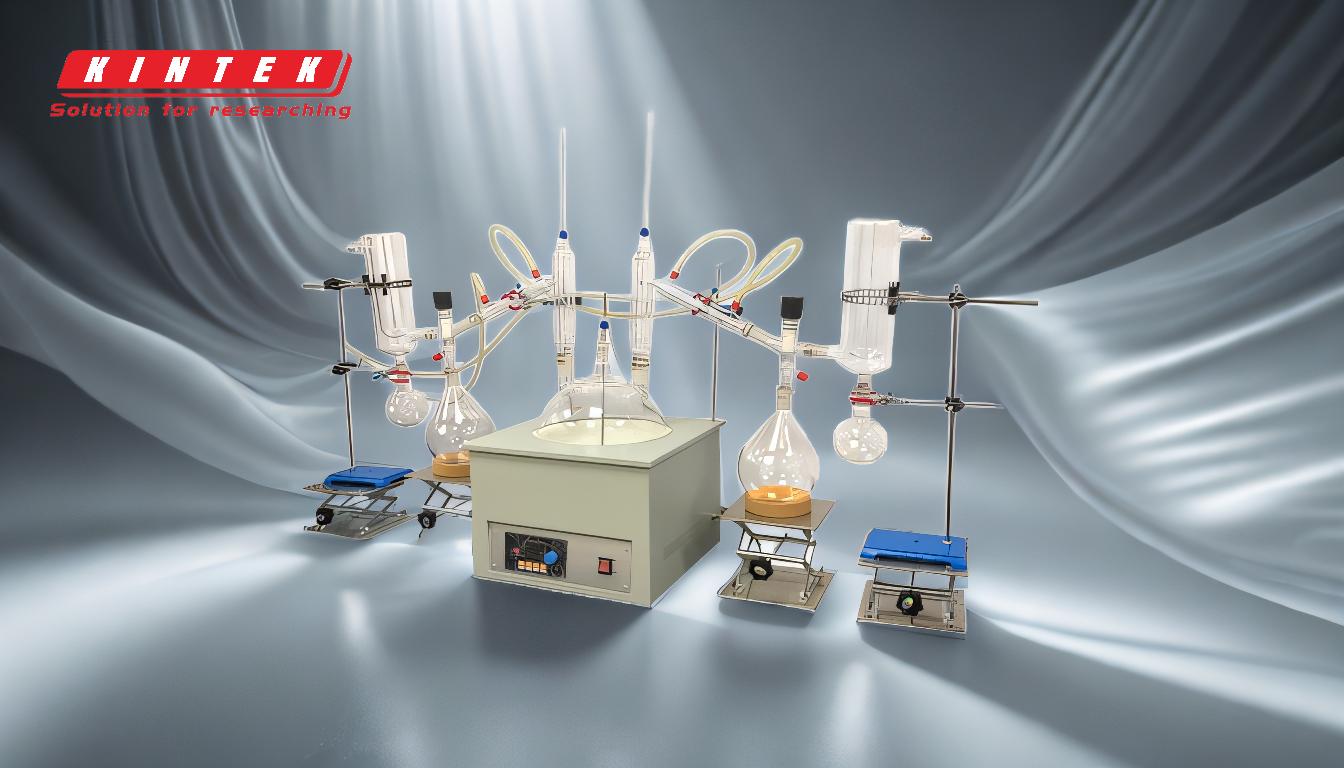Short-path distillation is a specialized technique used to separate and purify compounds, particularly those with high boiling points or heat-sensitive materials. It operates under reduced pressure to lower boiling points, minimizing thermal degradation. The process involves heating a liquid mixture in a boiling flask, vaporizing the compounds, and then condensing them over a short distance into separate fractions. This method is highly efficient for isolating specific components, such as cannabinoids, essential oils, or other complex mixtures. Key steps include preparing the material, assembling the apparatus, applying vacuum, heating, and collecting fractions in separate flasks. The process is repeatable for further refinement.
Key Points Explained:

-
Preparation of Material:
- Winterization and Decarbing: Before distillation, the material may undergo winterization (removing fats and lipids) and decarbing (activating compounds through heat). This ensures the material is free of impurities and ready for distillation.
- Loading the Boiling Flask: The prepared material is loaded into the boiling flask, which is equipped with a magnetic stirrer to ensure even heating and prevent localized overheating.
-
Assembling the Apparatus:
- Glassware Setup: The distillation apparatus consists of a boiling flask, condensing head, and multi-position receiver. All glassware must be securely assembled to prevent leaks.
- Greasing Joints: High-vacuum grease is applied to the joints to ensure an airtight seal, which is critical for maintaining the vacuum and preventing contamination.
-
Applying Vacuum:
- Reduced Pressure: A vacuum pump is used to reduce the pressure inside the system. This lowers the boiling points of the compounds, allowing them to vaporize at lower temperatures and reducing the risk of thermal degradation.
- Vacuum Optimization: The vacuum level is adjusted based on the material being distilled to ensure optimal separation of compounds.
-
Heating and Vaporization:
- Gradual Heating: The boiling flask is heated gradually to predefined temperatures. The heating rate is controlled to ensure that compounds vaporize at their respective boiling points.
- Magnetic Stirring: The magnetic stirrer ensures uniform heating and prevents the material from scorching or degrading.
-
Condensation and Collection:
- Short Distance Travel: The vaporized compounds travel a short distance (a few centimeters) to the condensing head, where they are cooled and condensed back into liquid form.
- Fraction Collection: The condensed liquid is collected in separate receiving flasks based on weight and boiling points. This allows for the isolation of specific components, such as cannabinoids or essential oils.
-
Repeatable Process:
- Multiple Passes: The distillation process can be repeated multiple times to further refine and purify the fractions. Each pass increases the purity of the collected compounds.
- Final Refinement: After distillation, the collected fractions may undergo additional processing, such as filtration or further purification, to achieve the desired level of purity.
-
Applications:
- Cannabinoid Isolation: Short-path distillation is widely used in the cannabis industry to isolate and purify cannabinoids like THC and CBD.
- Essential Oil Extraction: The technique is also used to extract and purify essential oils from plant materials.
- Chemical Synthesis: In laboratories, short-path distillation is employed to separate and purify complex chemical mixtures.
By following these steps, short-path distillation provides a highly efficient and precise method for separating and purifying compounds, making it an invaluable tool in industries ranging from cannabis to essential oils and chemical synthesis.
Summary Table:
| Step | Key Details |
|---|---|
| Preparation | Winterization, decarbing, and loading into the boiling flask. |
| Apparatus Setup | Secure glassware assembly with high-vacuum grease for airtight seals. |
| Vacuum Application | Reduced pressure lowers boiling points, minimizing thermal degradation. |
| Heating & Vaporization | Gradual heating with magnetic stirring ensures uniform vaporization. |
| Condensation & Collection | Compounds travel a short distance, condense, and are collected in fractions. |
| Repeatable Process | Multiple passes refine and increase purity of collected compounds. |
| Applications | Cannabinoid isolation, essential oil extraction, and chemical synthesis. |
Discover how short-path distillation can enhance your purification process—contact our experts today!










